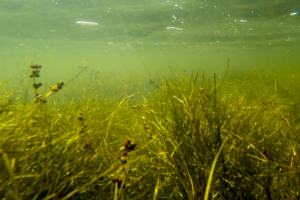
Submerged aquatic vegetation, or bay grasses, in the Severn River Sanctuary in Anne Arundel County, Md., on July 10, 2016. (Photo by Will Parson/Chesapeake Bay Program)
Scientists from the Virginia Institute of Marine Science (VIMS) have led surveys of underwater grasses since 1979. In 2017, they recorded 104,843 acres of grasses, exceeding the Chesapeake Bay Program’s (CBP) restoration target and meeting 57% of the restoration goal in the Chesapeake Bay Watershed Agreement. The 2017 survey continues a trend of three years of record growth.
The team, led by Robert “JJ” Orth who started the program, reported finding grasses in two areas of the Bay that hadn’t had grasses since 1972. They reported grasses in the upper York River and near the Mumfort islands in the lower York River as well as in front of the University of Maryland Center for Environmental Science (UMCES) Lab at Solomons Island in the Patuxent River.
In more saline regions of the Bay, such as Hampton Roads, there has been a strong increase in grasses, particularly eelgrass. Moderately salty areas have had increases in widgeon grass, and tidal fresh areas have had increases in wild celery and water stargrass.
The entire Rappahannock and Chickahominy rivers in Virginia exceeded their restoration goals, and segments of the James, upper Pamunkey, upper Potomac, and upper Mattaponi also exceeded goals. Grasses in the upper parts of the James increased 389% over the past year.
Jim Edward, acting director of CBP, said in a statement announcing the results, “Seeing record growth in underwater grasses for the past three years reinforces that our efforts to restore the Chesapeake Bay and its local tributaries are working.”
